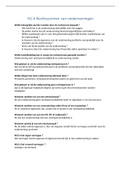Samenvatting
Samenvatting Campbell leerjaar 1 en 2 BMO
- Vak
- Instelling
- Boek
Alle hoofdstukken van Campbell die nodig zijn voor de opleiding biologie en medisch laboratoriumonderzoek voor leerjaar 1 en 2. Het is een samenvatting over de 11e druk. Het bevat dus onder andere de vakken; celbiolgie, DNA & evolutie, voeding en energie, anatomie en fysiologie en nog veel meer.
[Meer zien]













